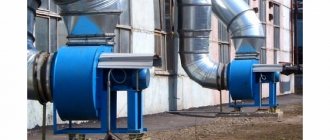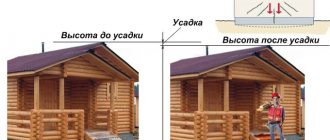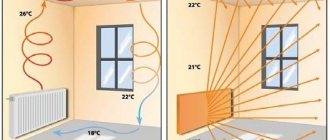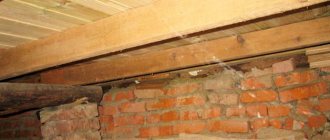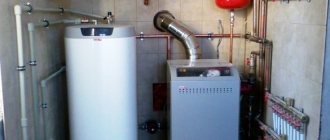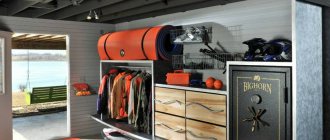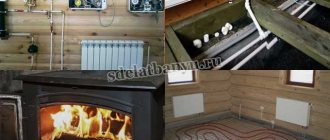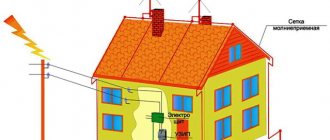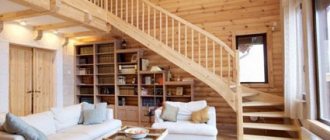Surely, you don’t know what difficulties you may encounter if you decide to use stove heating with a water circuit in a wooden house! There is a “hackneyed” stereotype that it is difficult to heat a house with a stove if you do not run a water circuit throughout the house, but this is not true! The water circuit in the furnace causes a lot of problems both during installation and operation.
In this article I will try to weigh the pros and cons, and it’s up to you to decide... And at the end I will show a short video from a real house under construction, where the furnace-boiler is made with a water circuit. We will talk about wood stoves.
Types of heating systems
To organize space heating, you can use several heat sources at once. Heating installation in a wooden house can be done using the following heat generators:
- bake;
- fireplace (classic or modernized);
- gas convector;
- electric convector;
- heat gun.
When choosing a suitable option, it is worth considering how light and easy it will be to operate. The cost of equipment maintenance becomes an important factor; sometimes incorrect calculations lead to unnecessary costs. The same applies to reducing heat losses to a minimum. An important role when creating heating in a wooden house with your own hands is played by the aesthetic appearance of the units and their compliance with the chosen interior.
Video description
About a wood stove in a heating system, watch the following video:
When choosing, you should first of all pay attention to the technical and operational characteristics:
- dimensions of the furnace itself;
- availability of additional devices;
- thermal capacity;
- the material from which it is made.
Brick and metal are the most popular materials for stove construction Source teplomact.ru
Distinctive features of pumping systems
The movement of the coolant at a suitable speed is ensured by a special pump. This helps to avoid temperature loss and also leads to faster heating of the premises.
A common system is a system with natural water circulation. Due to the difference in pressure, the liquid returns to the boiler after cooling. The warming up process is carried out more slowly, but the cost of installing a system of this type is more affordable for a wide range of buyers.
High efficiency can be achieved by installing a circulation pump. The use of such a system makes it possible to use pipes of smaller diameter. With natural circulation, the volume of heated space is limited; when operating a circulation pump, there are no space restrictions. Additional equipment requires money to be spent at the purchase stage, but the efficiency of its use will reduce fuel consumption, so it will bring tangible benefits.
Heating boiler diagram
Water heating in a wooden house cannot be imagined without a boiler that provides heating of the coolant. The boiler is a device operating in automatic mode. There are several types of equipment that use different types of fuel.
Heating boiler diagram
The heating system in a wooden house can be installed using the following types of boilers:
- gas;
- electrical;
- diesel;
- working on solid fuel.
It is worth considering separately the features and types of infrared heating. This model of heating system uses electricity to operate, and at the same time has economical consumption compared to electric boilers. The disadvantage of this option is the inability to heat large rooms; often infrared equipment plays a supporting role.
What can you save on?
When purchasing equipment and installing a heating system, the issue of saving invariably arises. Correct calculations of power will allow you to spend less money, while in terms of comfort you will not lose anything. For example, there are several options for installing a gas boiler in a wooden house. The heat exchange pattern and overall efficiency depend on its location.
The efficiency of the system depends on how good the heating radiators are, which ones are best to use in a particular situation, calculations will show. These elements may have different designs. A massive element will not be highly efficient if you need to heat a small room. Radiators according to the type of material used are divided into the following types:
- aluminum (they can be cast or obtained as a result of processing a workpiece);
- panel steel (ease of installation, efficiency of use);
- cast iron products (they take a long time to heat up, but can be used for more than half a century);
- tubular steel;
- modern bimetallic structures.
If gasification is present, you should first consider options using gas for heating. Options may vary in cost; you can always choose the best option for a particular case. It is possible to install a stove under a gas boiler, which will make your life more comfortable.
Methods of heating a wooden house
Approximate diagram of water heating in a wooden house
In wooden houses you can use all known heating systems, from Russian stoves to modern infrared emitters. But when installing some heating devices in a wooden house, it is necessary to take into account a number of nuances. Wood has very low thermal conductivity and high thermal insulation properties. That is, it heats up for a long time and maintains the temperature inside the house well, regardless of the outside temperature. That is why it is warm inside wooden houses and remains cool in the summer. And well-chosen heating devices should make maximum use of the physical properties of wood as a building material.
The efficiency of heating a wooden house largely depends on its area and number of floors. For a small country house, a stove and one stack of firewood is quite enough. A two-story residential mansion should be equipped with a more solid system. The most widespread is water heating with pipe distribution throughout all rooms and a radiator system. Water heating can operate from various sources: solid fuel, gas, electricity. The choice of source of thermal energy affects the choice of boiler, while the piping itself is practically independent of the method of heating it. You can see an approximate diagram of water heating in a wooden house in the figure.
Recommendations for carrying out construction activities
When constructing a stove with a hob and a water circuit, the following standards must be adhered to:
- The stove and nearby surfaces must be separated by a safe distance. For these purposes, a metal sheet is additionally installed in front of the firebox to protect the floor and partitions.
- To make the masonry as strong as possible, every 4th row of bricks is reinforced with metal pins.
- A clay mortar of medium plasticity is used as a mounting mixture. A small ball rolled from it should not crack or crumble when it hits the floor.
- The chimney must have a height of at least 5 m: the presence of a head is a prerequisite. This element is designed to protect the chimney from climatic precipitation and blockages. In addition, it helps to increase traction and decorate the building.
Building a home stove with a boiler with your own hands usually does not cause any particular difficulties. Quite often you can find metal structures that are not inferior to brick ones in terms of external aesthetics. Such a product can greatly decorate a home interior. For the construction of brick kilns, a special building material is selected. The best option is fired ceramic red bricks. They are distinguished by their uniform color and metallic sound when tapped.
DIY construction
First, a project is prepared, after which a heat exchanger is made according to the drawings, which should subsequently be installed in the stove. Actually, the stove is built according to its dimensions.
When designing, you need to think about how the device will be located in the room. The place must be user-friendly and accessible to the public.
After the foundation is installed, the brick is prepared for laying. It must be fireproof, without any chips, damage or cracks. It is also necessary to provide in the project the location of the blower and combustion chamber, smoke exhaust, and hob. The latter may not be installed, it all depends on the preferences of the home owners.
Construction occurs in a certain order:
- First, a solution is prepared. It consists of water, clay and sand. This mixture can be purchased ready-made in specialized stores, but experienced craftsmen make it themselves.
- The foundation is insulated with a layer of film or roofing felt.
- A uniform layer of mortar is laid on top and the first rows of bricks are laid.
- A firebox and ash pan are being installed. The accuracy of the masonry must be checked using a building level.
- Next, the door is fixed and the vault is made. A chimney is also installed. For the walls of the chimney you need to use semicircular bricks.
- At the final stage, the water circuit is installed. Pipes and batteries are connected, as well as a heat exchange tank. After this, the liquid is poured. You can use plain water or prepared solutions.
You can also decorate the stove if desired. You can make an economical stove device yourself. Such a device is durable, has a high efficiency, so the house will receive an installation independent of centralized heating.
Building materials and stove fittings
To make a Russian mini-oven with your own hands, you need to buy components and materials:
- solid ceramic bricks – 670 pieces (the chimney is counted separately);
- fireclay bricks for the firebox – 25 pcs. (brand ША-8);
- fireclay block brand ШБ-94 or similar in size – 1 pc.;
- door of the main chamber mouth 25 x 28 cm, possible with fireproof glass;
- loading door 21 x 25 cm;
- ash pan door 14 x 25 cm;
- two grates measuring 300 x 250 and 220 x 325 mm;
- wooden template - circle - radius 460 mm, length - 65 cm;
- cast iron hob with 2 burners 71 x 41 cm;
- 3 valves: 13 x 25 cm - 2 pcs., 260 x 240 x 455 mm - 1 pc. (brand ZV-5);
- equal angle corner 40 x 4 mm – 3 meters;
- steel sheet 1 mm thick for a shelf in a stove;
- galvanized mesh for reinforcement, cell 3 x 3 cm - 2.1 lm;
- kaolin wool, corrugated cardboard.
Red brick laying is done using sand-clay mortar. When constructing a chimney, it is allowed to add M400 cement. Fireproof stones are placed on another solution - fireclay clay, mortar and the like.
Laying progress - step-by-step instructions
A reinforced concrete or rubble concrete foundation is cast under the furnace, the dimensions of which are 10 cm greater than the dimensions of the structure. Start construction when the concrete reaches 75% strength; under normal conditions, the hardening process will take about 2 weeks. This assumes an average daily air temperature of +20 °C and proper care of the monolith.
Having installed waterproofing from 2 layers of roofing material, make the first row continuous (40 bricks will be needed). How to fold the stove according to the order, read on:
An ash chamber is formed on 2-3 tiers, a cleaning door is installed, and columns are built to support the bottom of the furnace. The 4th row continues the main walls of the stove; the ash chamber is covered with cut stones. Rows 5-6 form the main smoke channel and the bottom of the firebox made of refractory bricks. The grate is installed without mortar; a row of fireclay stones placed on edge is placed on top.
On the 7th tier a loading door and a vertical summer shutter are installed. Rows 7-9 are laid according to the pattern, at the end the fireclay brick is covered with kaolin wool (marked in green)
Please note: on the seventh tier the walls are reinforced with steel mesh.
Rows 10 and 11 partially cover the flues and the lower heating chamber; a grate for the furnace and a hob are installed. The 12th tier begins to form the main firebox, and on the 13th tier the door is attached to the mouth of the furnace.
Rows 14-17 are laid according to the diagram, corners are mounted to cover the cooking opening
On the 18th tier, steel profiles are covered, and an arched vault with a radius of 46 cm is built from wedge-shaped stones. Tiers 19, 20 are made according to the scheme, the cavity between the vault and the walls is filled with sand or filled with thick masonry mortar. When the filler dries, 21 rows are laid - the roof.
From 22 to 32 tiers the front part of the heater is built. On the 24th row, both smoke valves are placed, on the 25th - an iron shelf measuring 42 x 32 cm. Having laid the 29th tier, cover the stove with the same sheet.
To understand the construction down to the smallest detail, we suggest watching a video with a detailed demonstration of the masonry of each row and explanations from the master:
Criteria for choosing a heat generator
There is simply a huge selection on the market - domestic and foreign manufacturers offer a wide variety of models. From such an assortment, a buyer with any income level will be able to choose something for himself.
In order not to make a mistake when buying a boiler, you need to check what type of fuel is most available in the region. It is also important to correctly calculate the power of the equipment.
Advantages of gas units
The vast majority of owners of wooden houses opt for gas equipment.
The popularity of wall-mounted and floor-standing gas boilers is due to the fact that such fuel is one of the cheapest in many countries. In addition, with its help you can organize a completely autonomous and maintenance-free heating system.
The list of advantages of gas boilers needs to be supplemented:
- High efficiency . Even a low-power device generates more heat than its counterparts running on other types of fuel.
- Ease of operation . No need to worry about where the fuel will be stored. At the same time, using such equipment is easy - you only need to set it up once.
- Durability . A high-quality gas unit will last at least 15 years.
The main disadvantage is the need to obtain special permission to install it. All other disadvantages are completely offset by advantages.
If you need to heat a large house with an area of more than 100 m2, then it is better to refuse a gas boiler. In this case, it will be an economically unprofitable solution
Water heating in a wooden house
The most common type of heating system is considered to be water-based, since water, moving through pipes, can heat the entire house. The advantages of a water heating scheme for a private house include a low price, as well as a good level of thermal conductivity. As for the downsides, it is the need to constantly keep the system actively heated, otherwise there is a risk of defrosting the entire house; it is for this reason that in addition to the water itself, antifreeze is also added to the liquid in order to constantly keep the water in liquid and not frozen form. The heating device in a wooden house of this type is:
- heating boiler;
- pipeline;
- heating radiator.
The entire structure also contains shut-off valves, in particular ball valves and heating level thermostats. This type of heating can be used to heat the room itself, the floor, and also to supply hot water. As for the principle of operation, in this case it is fashionable to distinguish two: natural circulation and artificial.
Pipe routing
A water heating system for a private house involves the use of three piping options - a single-pipe system, a two-pipe system and a collector system.
A single-pipe system is a system where the heated coolant (water) from the boiler sequentially flows from one battery to the next. Such a system has one big drawback - it is very difficult to control the wiring, since when water access to any of the radiators is blocked, the others are also blocked.
Single pipe system
In a two-pipe system, each radiator has a hot and cold water pipe. So, with such a system, water heating at home can be regulated very conveniently.
Two-pipe heating system
Another system is a collector system. It is also called radial. Here the mechanism works in this way: from the collector (which is a device that collects water) two pipes are supplied to each heating device - forward and return. Thanks to this, you can simply install a system with hidden pipe wiring, you can maintain a certain temperature regime in a separate room and regulate it.
Heating installation in a private house
Heating system installation
Self-installation forces you to take into account the following operating features:
- installation of special compensators;
- selection of material for pipelines and radiators;
- correct connection of all elements so that there are no leaks;
- wiring on all floors, reducing the number of risers to a minimum.
Installation of a heating system
It is worth deciding where the boiler room will be located in a wooden house. For its arrangement, basements or a separate extension can be used. There are always different options for how to attach a boiler room to a wooden house, differing in the cost of installation, the complexity of the work and the ease of subsequent operation.
Single pipe system
The heating system can have a different number of circuits; the single-pipe version is most common. A single-pipe system ensures that hot water rises due to the difference in mass and density with the colder part of the coolant.
Single pipe system
This option is best used for small houses, since with natural circulation the difference in temperature on different floors will be felt. A good way to get rid of this drawback is to use a circulation pump. It is worth calculating all the expenses to understand whether this option will have truly suitable efficiency.
Two-pipe system
If there are two circuits, the hot coolant enters the radiators through a separate line. This ensures faster heating of the rooms, as well as the same temperature in opposite parts of the building. In large houses, uniform heating is important, so this option is optimal there.
Two-pipe system
Sometimes there is a need to expand the house and make new extensions. When using a double-circuit heating system, this will not be a problem; such a system is considered scalable, that is, you can always extend any line. When building houses with a large area of premises, opt for a two-pipe system.
How to make a foundation for a stove correctly
For stoves with a low weight of up to 250 kg, a foundation is not needed at all. But for heavy brick structures it is necessary. Here you need to know that the stove is not placed on the main foundation of the house, since heat will escape through it to the outside.
The type of foundation is chosen separately in each case - depending on the foundation of the house and other factors. Most often they use monolithic, block or pile.
The foundation for the stove should be laid during the construction of the house. Therefore, its location should be determined in advance. If the stove needs to be installed in an already rebuilt house, and the floors in it are wooden, then you will have to cut through the floor and dig a pit for installing the foundation.
Foundation for a brick kiln Source lestorg32.ru
The base for the stove should not be in contact with the main foundation of the house and be at least 5 cm away from it. It is best to place a large, massive brick stove in the center of the house. This is the most optimal solution for uniform heating of rooms.
Air heating
Air heating of rooms in a wooden house is an innovative option that involves installing a heat gun, a fan and air ducts that supply warm air to the rooms. This design is economical to install and ensures quick heating of the room even in severe frosts.
The main advantages of air heating include:
- the ability to use the system in a house where people with allergies live;
- aesthetic design - the equipment has a hidden location, since the air ducts are built into the walls, and the heaters are installed in the utility room;
- high speed of heating the air in the room, reaching 20 minutes.
The following are noted as disadvantages of the system:
- drying out the air;
- the need for a separate architectural project for safe and convenient placement of air ducts;
- installation of a system of hatches for cleaning air ducts, which requires reconstruction of the house and additional investments;
- the presence of diffusers that create a lot of noise during operation.
Due to the pronounced disadvantages, hidden heating in a wooden house is most often used as an additional option, in the presence of water or electric heating.
Warm floor
Modern homes often use underfloor heating to create a more comfortable environment. If the power is correctly calculated, such a system can be used as a method of heating rooms if there is no severe frost outside. When using a water system, pipes are laid under the final coating, thereby heating the surface.
Warm floor
If you use an electric heating connection in a wooden building, you should definitely install heated floors. This will increase consumption slightly, but the increase in comfort will be clearly felt.
Underfloor heating is rarely used separately as heating; most often it is part of a combined system. When installing, take into account the need for additional thermal insulation to comply with fire safety regulations. Before installation, it is worth taking care of the possibility of temperature control in order to control the condition of the system.
Alternative methods of water heating of a private house
In addition to traditional heating using a heating boiler, there are other types of water heating for a private home. Such modern systems are effective as the main heating systems of a house, or additional ones.
Very often today you can hear such a phrase - “warm floor” system. In principle, heated floors are the same water heating of private houses, which can also be used as an addition to the main heating. Warm floors have advantages - there is a large heat transfer area. Indeed, in this case, the floor of the room is practically a large radiator. And the air warms up correctly in this way - it’s warm below, and a little cooler above.
Warm water floor
Thanks to the heated floor system, you can reduce the operating temperature of the coolant (no more than 55 degrees Celsius). You can also set the thermal power within the required limits.
The disadvantages of a heated floor system are that such a system is difficult to install, and if the renovation is already completed, this is impossible, or you will have to raise the floor or deepen it.
Another option for alternative water heating is baseboard heating. In fact, baseboard water heating of houses is a cross between a radiator system and a heated floor. In this case, heating equipment is placed around the perimeter of the room at the baseboard level. Thanks to this, both the walls and the floor are heated evenly. The air in the room is also uniform. With such a system, water heating of a country house or private house will allow you to furnish the interior without large radiators, and all this without heat loss.
Baseboard heating
Using solar energy
If you live in a sunny region of Russia, then solar panels will be an excellent solution for you, which will generate heat and heat water most of the year. You won’t have to pay utility bills every month, and the heat will be taken “out of thin air.” This is suitable for owners of summer cottages that are used only periodically, for example, for planting crops in the garden and for a summer holiday in a cozy country house. Consumers who install such systems are not afraid of power outages. You can also use photovoltaic panels, which are used as an additional power source. If there are power outages, the energy from such devices will be enough to keep boilers and heaters running for several hours, as well as watch TV and charge your phone.
Contrary to all stereotypes: a girl with a rare genetic disorder conquers the fashion world. This girl's name is Melanie Gaydos, and she burst into the fashion world quickly, shocking, inspiring and destroying stupid stereotypes.
11 Weird Signs That You're Good in Bed Do you also want to believe that you please your romantic partner in bed? At least you don't want to blush and apologize.
7 Body Parts You Shouldn't Touch with Your Hands Think of your body as a temple: you can use it, but there are some sacred places that you shouldn't touch with your hands. Research showing.
9 Famous Women Who Have Fallen in Love with Women Showing interest in people other than the opposite sex is not unusual. You are unlikely to be able to surprise or shock anyone if you admit it.
10 charming celebrity children who look completely different today Time flies, and one day little celebrities become adults who are no longer recognizable. Pretty boys and girls turn into...
20 photos of cats taken at the right moment Cats are amazing creatures, and perhaps everyone knows this. They are also incredibly photogenic and always know how to be in the right place at the right time.
